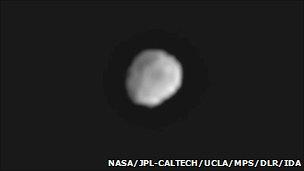Asteroid Vesta comes into focus
- Published

Getting closer: Vesta is missing a big chunk out of its south polar region
The Dawn spacecraft is starting to get an eye-full of the Vesta asteroid.
The probe expects to reach the 530km-wide body in late July, whereupon it will go into orbit around the rock.
Vesta is what scientists term a protoplanet - a body that never acquired the proportions of "grown-up" planets such as Earth and Mars.
It is nonetheless an impressive object - the second most massive asteroid in the belt of rocky debris that orbits between Mars and Jupiter.
Nasa's (US space agency) Dawn satellite will be spending about 12 months at Vesta before moving on to Ceres which, at 950km in diameter, is by far the largest and most massive body in the asteroid belt.
The new images released on Monday are a big improvement on the dot-like navigation shots released last month that were used to fine-tune the probe's approach to the rock.
The latest pictures were acquired on 1 June, from a distance of about 480,000km. Vesta's irregular form is now unmistakeable. In the images, one pixel corresponds to 45km on Vesta's surface.
In the days since 1 June, Vesta has started to acquire pictures with resolutions of around 30km per pixel - slightly better than the best shots we have from the Hubble Space Telescope.
"This is really a new world which we've never seen before, so it should be very exciting," said Dr Andreas Nathues from the Max Planck Institute for Solar System Research (MPS) in Germany which processed the imagery.
"We will have five times Hubble resolution by the beginning of July," he told BBC News.
The asteroid has the look of a punctured football, the result of a colossal collision sometime in its past that ripped a big chunk out of its south polar region (the five o'clock position).
The debris from that smash-up was sent far and wide. About one in every 20 meteorites that falls on the surface of the Earth is probably a bit of Vesta.
Ceres and Vesta will make for interesting subjects. They are both evolved bodies - objects that have heated up and started to separate into distinct layers.
In the case of Vesta, telescopes have spied evidence for the eruption of lava (basalt) on its surface.
"The goal is to acquire the first colour pictures of Vesta in early July," said Dr Nathues. "We will go into three different kinds of orbits and the last of these will be about 200km in height from the surface. The best resolution at that stage will be about 20m per pixel."
- Published13 October 2010
- Published10 July 2010